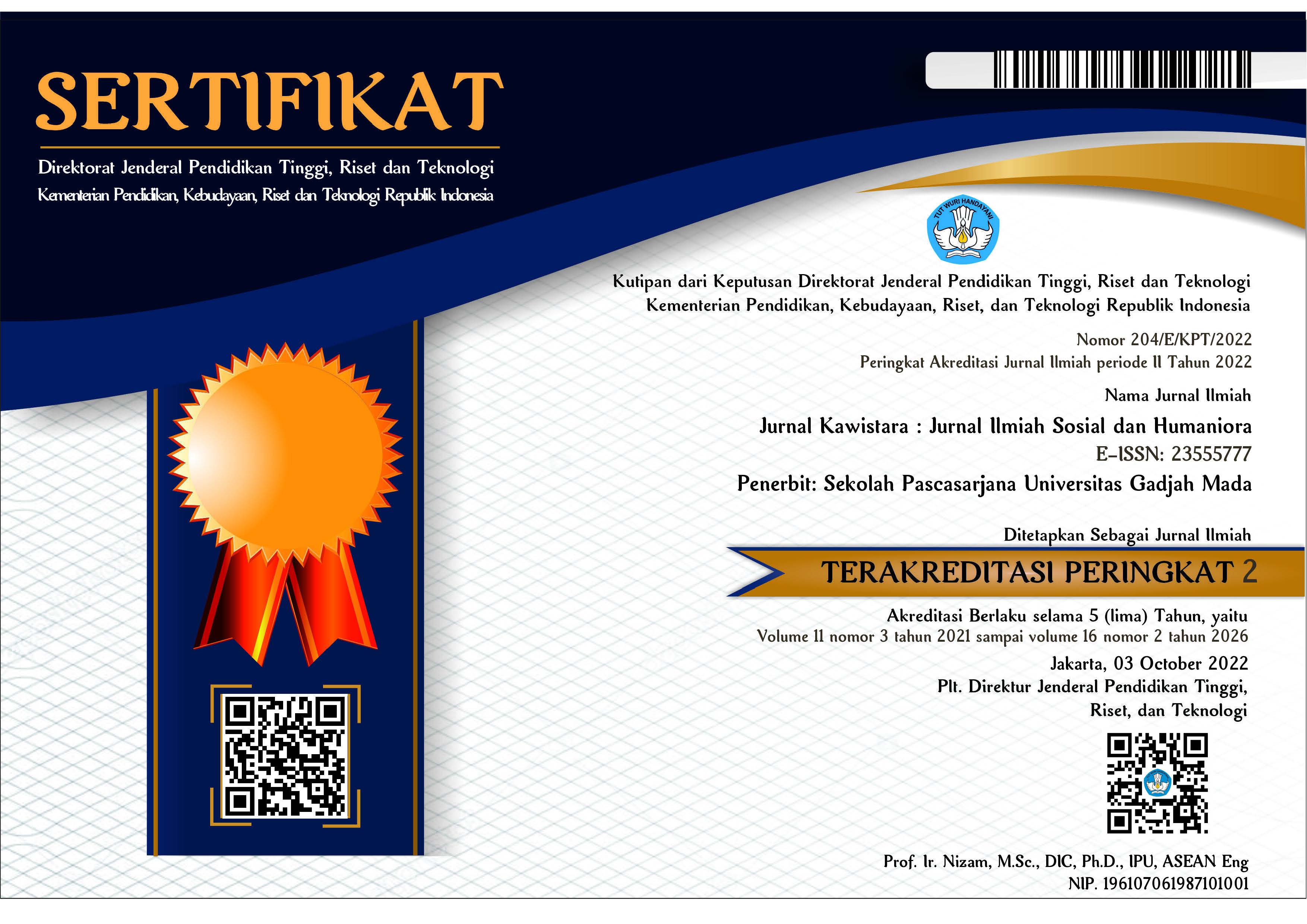PROPORSI ADAT BUDAYA DI BALI DAN PENGARUHNYA TERHADAP KESEJAHTERAAN MASYARAKAT LOKAL
Ni Putu Wiwin Setyari(1*), I Komang Gde Bendesa(2), Ida Ayu Nyoman Saskara(3)
(1) Fakultas Ekonomi dan Bisnis, Universitas Udayana
(2) Fakultas Ekonomi dan Bisnis, Universitas Udayana
(3) Fakultas Ekonomi dan Bisnis, Universitas Udayana
(*) Corresponding Author
Abstract
A lot of the views of practitioners outside of Bali looked at the ceremony as one of the causes of poverty. It is seen from the portion of income that must be spent for various ceremonies to be performed by the Balinese Hindu community. This study aimed to answer the fundamental question, whether it is the customs and cultures led to affect Hindu community income in Bali? The data used is primary data from 350 Hindu households listed as poor households in Bali using depth interview survey method. Religion can play a role in overcoming poverty. Religion is not only a moral conscience that reminds the community will give generously to the poor but also to see the poor as human beings. The opinion says that the religious activities and custom made by Balinese Hindu communities causes increased poverty seems supported by the magnitude of the data portion of the expenditures for this activity. In Balinese Hindu communities, family income will be issued again and consumption expenditure shaped yajna. The analysis shows if traditional rituals and Balinese Hindu religious tend to have positive influence, good for people's income and the level of happiness. Therefore, it is not appropriate if the customs and religion are said to have made the Balinese Hindu community becomes poorer. This result also shows a shift in the understanding of religion in Balinese Hindu community. Religiosity someone then be interpreted by the implementation of the ritual in the form of upakara (yadnya) and the implementation of ethics in public life (susila).
Keywords
Full Text:
PDFReferences
Ade, C. (2004). Bagaimana Kemiskinan Diukur?: Beberapa Model Penghitungan Kemiskinan di Indonesia, 1–8. https://doi.org/10.17528/cifor/001641
Aghili, M., & Kumar, V. (2008). Relationship between Religious Attitude and Happiness among Professional Employees. Journal of the Indian Academy of Applied Psychology, 34(Special Issue), 66–69.
Alkire, S., & Santos, M. E. (2010). Multidimensional Poverty Index. Oxford Poverty and Human Development Initiative, (July), 1–8. https://doi.org/10.12973/eurasia.2015.1400a
Anwar, T. (2005). Prevalence of relative poverty in Pakistan. Pakistan Development Review, 44(4 PART II), 1111–1128. https://doi.org/10.1016/j.aprim.2010.09.028
Badan Pusat Statistik Indonesia. (2016). Penghitungan dan Analisis Kemiskinan Makro Indonesia. Jakarta: Badan Pusat Statistik.
Badan Pusat Statistik Indonesia. (2017). Survey Indeks Kebahagiaan. (T. Na’im. Akhsan; Aryanti, Diana; Karmaji; Suryaningsih, Ed.). CV. Dharmaputra.
Badan Pusat Statistik Indonesia. (2019). Profil Kemiskinan di Indonesia. Berita Resmi Statistik Kemiskinan Provinsi Bali. Profil Kemiskinan di Bali September 2018 (Vol. 08/01/51 T).
Beyers, J. (2014). The effect of religion on poverty. HTS Teologiese Studies / Theological Studies, 70(1), 1–8. https://doi.org/10.4102/hts.v70i1.2614
BPS Provinsi Bali. (2017). Indeks Kebahagiaan Provinsi Bali Tahun 2017. Retrieved from https://bali.bps.go.id/pressrelease/2017/08/15/717010/indeks-kebahagiaan-bali-2017-sebesar-72-48.html
Budiana, I. N. (2004). Rekonstruksi Sosial Perkawinan Eksogami di Tengah Perubahan Sosial di Bali. Universitas Airlangga. Retrieved from http://repository.unair.ac.id/32556/
Colón-bacó, E. (2010). The Strength of Religious Beliefs is Important for Subjective Well-Being The Strength of Religious Beliefs is Important for Subjective Well-Being, 6(1), 1–27.
Forgeard, M. J. C., Jayawickreme, E., Kern, M. L., & Seligman, M. E. P. (2011). Doing the Right Thing: Measuring Well-Being for Public Policy. International Journal of Wellbeing, 1(1), 79–106. https://doi.org/10.5502/ijw.v1i1.15
Heath, A., Li, Y., & Road, O. (2015). Review of the Relationship Between Religion and Poverty-an Analysis for the Joseph Rowntree Foundation (No. 2015-01). CSI Working Paper.
Israel, G. D. (1992). Determining Sample Size (No. PEOD6). IFAS Extension. https://doi.org/10.1007/11915034
Norcia, M., & Rissotto, a. (2013). How Religious Faith Affects Beliefs on Poverty: A Study in Italy. International Journal of Social Science and Humanity, 3(2), 180–185. https://doi.org/10.7763/IJSSH.2013.V3.223
Rojas, M. (2018). Happiness in Latin America Has Social Foundations. In J. D. Helliwell, John F.; Layard, Richard; Sachs (Ed.), WORLD HAPPINESS REPORT. New York: United Nations.
Rothstein, B. (2010). Corruption, Happiness, Social Trust and the Welfare State: A Causal Mechanisms Approach. Political Science, (April), 24. Retrieved from https://www.qog.pol.gu.se/digitalAssets/1350/1350166_2010_9_rothstein.pdf
Sillick, W. J., Stevens, B. A., & Cathcart, S. (2016). Religiosity and happiness : A comparison of the happiness levels between the religious and the nonreligious, 4(1), 115–127.
Small, M. L., Harding, D. J., & Lamont, M. (2010). Reconsidering culture and poverty. Annals of the American Academy of Political and Social Science, 629(1), 6–27. https://doi.org/10.1177/0002716210362077
Sukarsa, I. M. (2005). Pengaruh Pendapatan Keluarga dan Pemahaman Agama terhadap Pengeluaran Konsumsi Ritual Masyarakat Hindu di Bali ditinjau dari Berbagai Dimensi Waktu. Universitas Airlangga. Retrieved from repository.unair.ac.id/32405/13/gdlhub-gdl-s3-2007-sukarsaima-3651-dise19-6.pdf
Sukrawati, N. M. (2017). Nilai Didaktis Upacara Pacaruan Sasih Kaenem di Pura Pasek Ngukuhin, Desa Pakraman, Tonja, Kota Denpasar. Dharmasasmrti, XVII(02), 86–97.
Sukrawati, N. M. (2018). Pendidikan Acara Agama Hindu : Antara Tradisi dan Modernitas, 9(2), 43–49.
Article Metrics
Refbacks
- There are currently no refbacks.
Copyright (c) 2019 Ni Putu Wiwin Setyasari, dkk.

This work is licensed under a Creative Commons Attribution-ShareAlike 4.0 International License.
Jurnal Kawistara is published by the Graduate School, Universitas Gadjah Mada.








